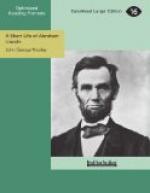The joint resolution was called up in the House on January 6, 1865, and general discussion followed from time to time, occupying perhaps half the days of that month. As at the previous session, the Republicans all favored, while the Democrats mainly opposed it; but important exceptions among the latter showed what immense gains the proposition had made in popular opinion and in congressional willingness to recognize and embody it. The logic of events had become more powerful than party creed or strategy. For fifteen years the Democratic party had stood as sentinel and bulwark to slavery, and yet, despite its alliance and championship, the “peculiar institution” was being consumed in the fire of war. It had withered in popular elections, been paralyzed by confiscation laws, crushed by executive decrees, trampled upon by marching Union armies. More notable than all, the agony of dissolution had come upon it in its final stronghold—the constitutions of the slave States. Local public opinion had throttled it in West Virginia, in Missouri, in Arkansas, in Louisiana, in Maryland, and the same spirit of change was upon Tennessee, and even showing itself in Kentucky. The Democratic party did not, and could not, shut its eyes to the accomplished facts.
The issue was decided on the afternoon of January 31, 1865. The scene was one of unusual interest. The galleries were filled to overflowing, and members watched the proceedings with unconcealed solicitude. “Up to noon,” said a contemporaneous report, “the pro-slavery party are said to have been confident of defeating the amendment; and after that time had passed, one of the most earnest advocates of the measure said: “’Tis the toss of a copper.” At four o’clock the House came to a final vote, and the roll-call showed: yeas, one hundred and nineteen; nays, fifty-six; not voting, eight. Scattering murmurs of applause followed affirmative votes from several Democratic members; but when the Speaker finally announced the result, members on the Republican side of the House sprang to their feet, and, regardless of parliamentary rules, applauded with cheers and hand-clappings—an exhibition of enthusiasm quickly echoed by the spectators in the crowded galleries, where waving of hats and handkerchiefs and similar demonstrations of joy lasted for several minutes.




